|
|
ARTHROPODS:
Insects»
Spiders»
Centipedes»
Millipedes»
Sowbugs»
Harvestmen»
Mites
& Ticks»
Scorpions»
Identification
Tips»
About
the Critter Files»
Links» |
|
|
|
| WESTERN
HERCULES BEETLES AND WESTERN/EASTERN HYBRIDS: |
|
In 2002, Bill Wallin
procured a few larvae of Dynastes granti, the Western
Hercules Beetle. After three years of development, 2 adult
males emerged and were mated with several adult females of Dynastes
tityus, the Eastern Hercules Beetle. Those females
laid eggs and the adults emerged in 2007.
Pictured below are
the two parental male Western Hercules Beetles. As with
Eastern Hercules Beetles, Westerns have highly variable spotting
patterns on the elytra.
|
| |
 Western Hercules
Beetle "R2": one of two parental males of Western/Eastern hybrids.
Western Hercules
Beetle "R2": one of two parental males of Western/Eastern hybrids.
Notice gray background, round dots, and bifurcate pronotal horn
(U. Savali, 2003) |
|
 Western Hercules
Beetle "D2": one of two parental male of
Western Hercules
Beetle "D2": one of two parental male of
Western/Eastern hybrids. (U. Savali, 2003) |
| |
| Differences
between Eastern and Western Hercules Beetles: The predominant
background color on the elytra of Eastern Hercules Beetles is brown,
tan, gray, or a combination, while the Western beetles are always gray. The
Western species is also characterized by having the pronotal horn
widely bifurcate on males, whereas Eastern males have a simple, straight
pronotal horn or a slight bifurcation. Also,
on Western Males, the pronotal horn extends much further past the
head than on Eastern males. |
| |
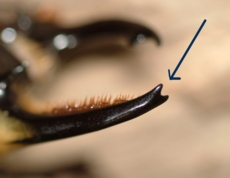 Close-up of bifurcate
male pronotal horn: a distinguishing character of the Western Hercules
Beetle. (B. Wallin, 2007)
Close-up of bifurcate
male pronotal horn: a distinguishing character of the Western Hercules
Beetle. (B. Wallin, 2007) |
|
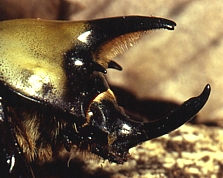 Close-up of male
Eastern Hercules Beetle. Notice short pronotal horn with slight
bifurcation.
Close-up of male
Eastern Hercules Beetle. Notice short pronotal horn with slight
bifurcation.
(B. Wallin, 2000) |
| |
| Hybrids:
Pictured below is a group of four F1 Western/Eastern hybrid male adults,
which emerged in Fall-Winter 2007. Elytra background colors
and pronotal horns exhibit a combination of the characteristics seen
on Eastern and Western individuals. In particular, note the
individual on the left. It shows the elytra color typical of Eastern
adults, but it also has a long pronotal horn, typical of Western adults. |
| |
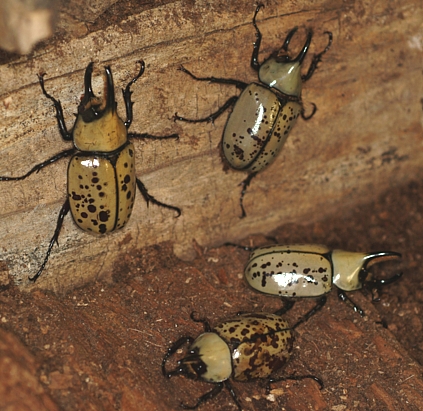 F1 Western/Eastern
Hybrids (B. Wallin, 2007)
F1 Western/Eastern
Hybrids (B. Wallin, 2007) |
| |
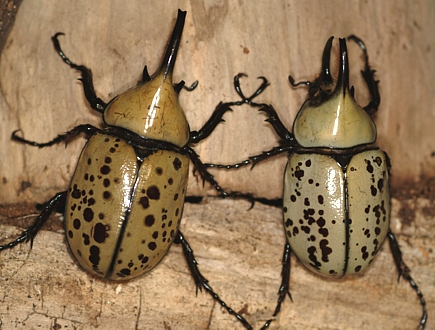 F1 Western/Eastern
Hybrids (B. Wallin, 2007)
F1 Western/Eastern
Hybrids (B. Wallin, 2007) |
| |
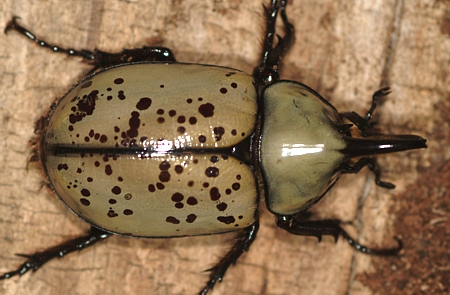 Close-up of F1
Western/Eastern Male (B. Wallin, 2007)
Close-up of F1
Western/Eastern Male (B. Wallin, 2007) |
| |
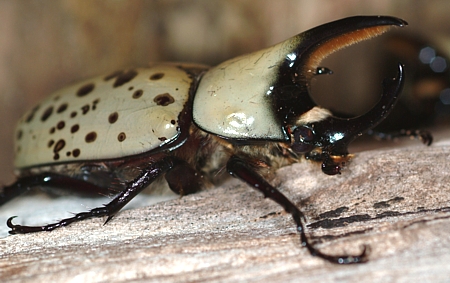 Close-up of F1
Western/Eastern Male (B. Wallin, 2007)
Close-up of F1
Western/Eastern Male (B. Wallin, 2007) |
| |
| Although the
Eastern and Western beetles readily mated and reproduced in a laboratory
setting, it is not known if they will do so in the wild. As
of Dec 2007, the F1 adults have been mated with one another and a
single female has laid twelve eggs which, so far, have produced four
1st instar larvae. |
| |
| Photos
By B. Wallin and Udo Savali, Univerisity of Kentucky, 2000-2007 |
Original document: 20 Dec 2007
Last updated: 20 Dec 2007
Photos courtesy B.
Wallin, R. Bessin, and U. Savali , University of Kentucky
The Kentucky Critter
Files are maintained by Blake Newton, Department of Entomology, University
of Kentucky.
Contact: blaken@uky.edu |
|

